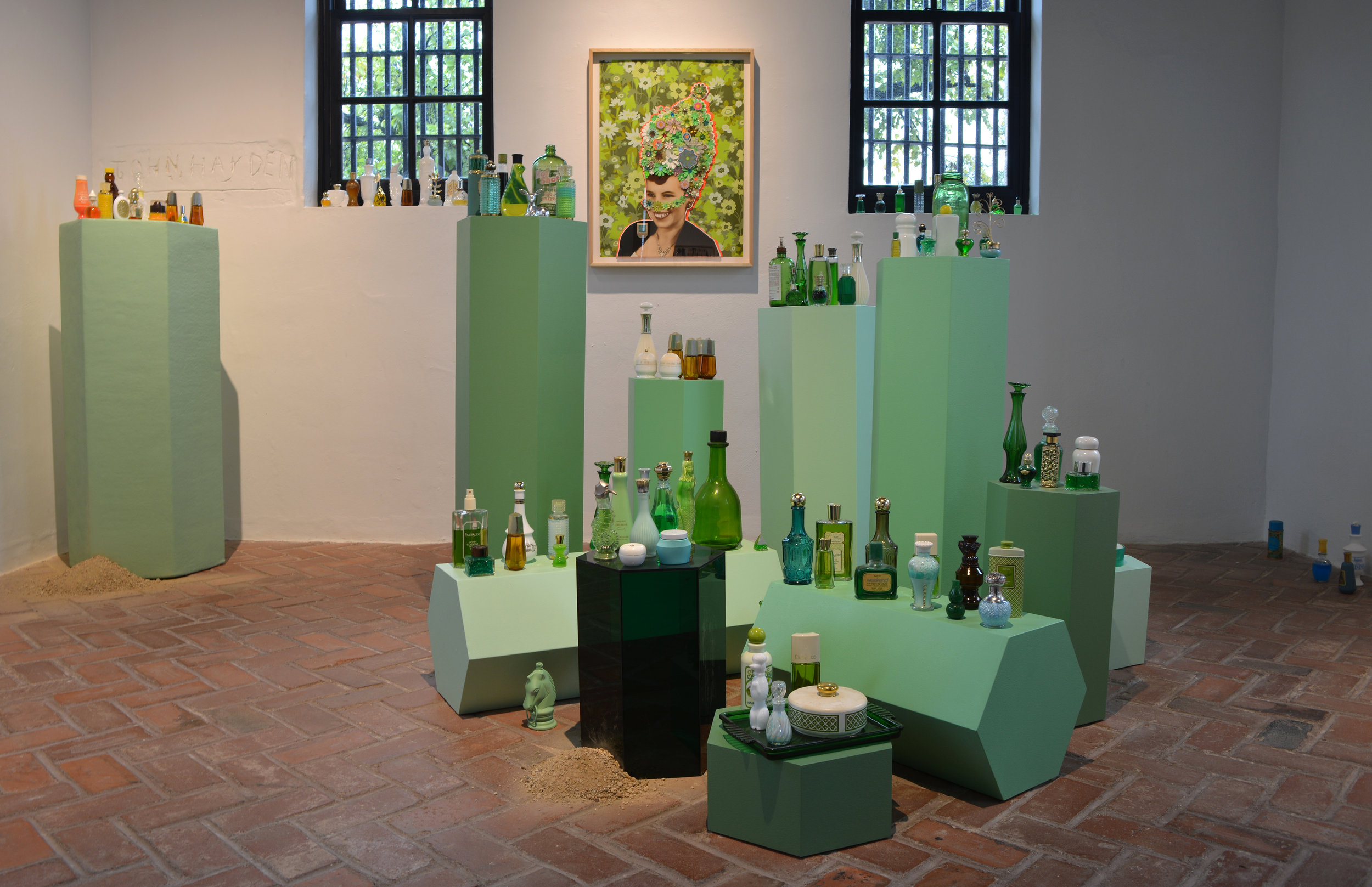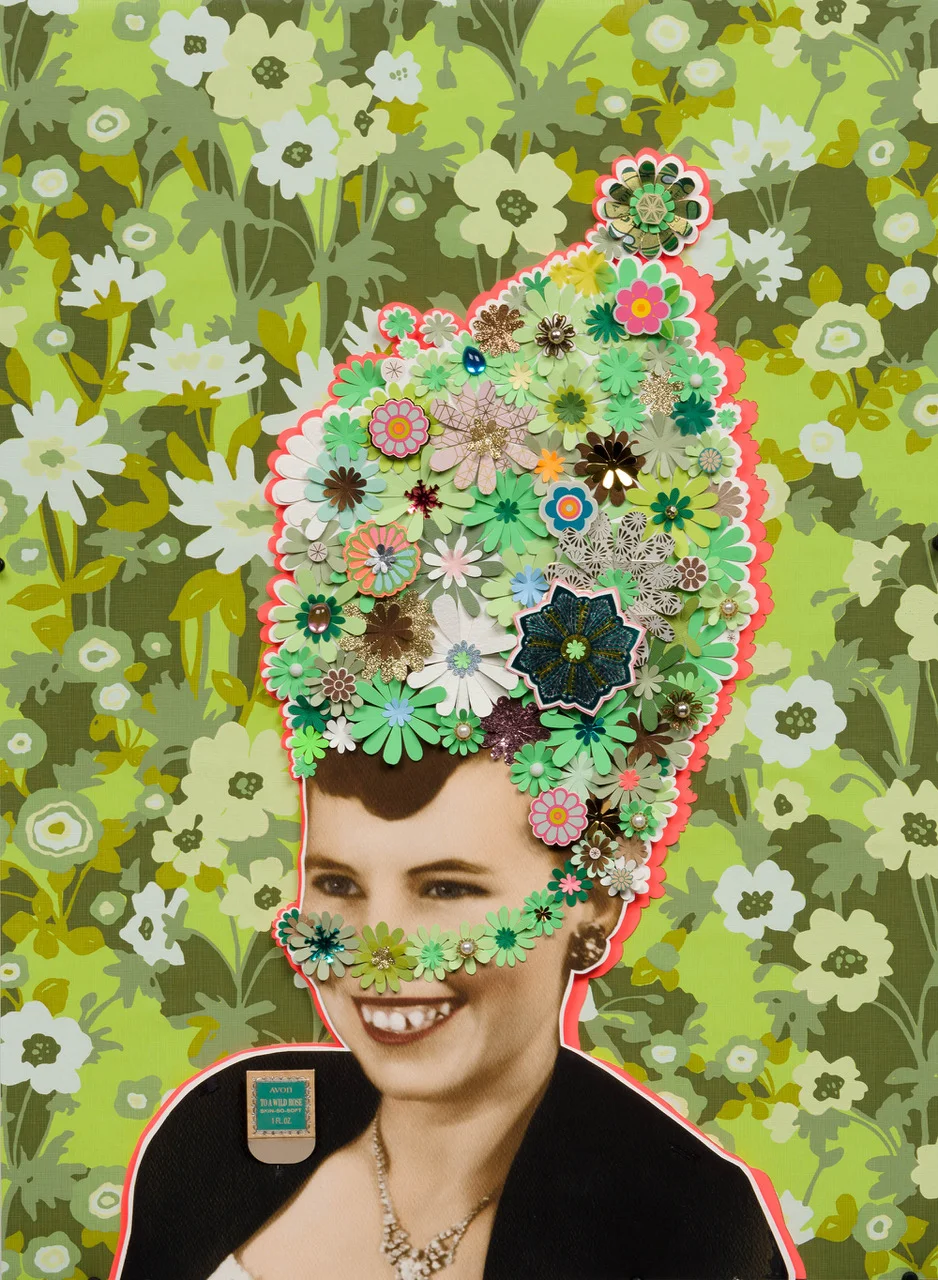What do the Emerald City of Oz and the city of Odessa, Texas have in common? For Kelly O’Connor, Oz represents a city of dreams and a means back to reality, while Odessa represents dreams bound by harsh realities.
In Kelly O’Connor’s site-specific installation in the upper galleries of the 1877 jail building, the artist attempts to reveal the similarities and polarities of the two cities and their inhabitants—one fantasy and one real—to weave a non-linear narrative. A visual excess of color, symbolic references, seemingly disparate objects, and perfume oil will become the sensory vehicles for viewers as they explore themes of authenticity, disillusionment, excess, and escapism. References to Judy Garland and O’Connor’s grandmother (both named Dorothy), “institutional” green used in jails and asylums, and other powerful imagery will await viewers in this complex and thought provoking installation.
For almost a decade, San Antonio artist O’Connor has appropriated images from paper media produced during the 1950s and 1960s in the creation of her collages and sculptures. Her work is less about nostalgia than understanding how myth and reality shape our understanding of the world.
Kelly O'Connor Interview
Patrick Kelly (OJAC Executive Director and Curator): Your past works often incorporated vintage Disney and “family travel attractions” from postcards and other ephemera. What is it about this imagery that attracts or interests you?
Kelly O'Connor: As a child I was first introduced to these destinations by my father through vacation memorabilia. I was a child of the 80s, but he had collected these vacation guides and postcards during his childhood in the 1960s. This particular ephemera portrays a much more utopian ideal very common directly after World War II.
Every summer my family of five would take a long road trip in our conversion van. We frequented amusement and national parks such as Disneyland and Yellowstone. These are my most cherished memories from my childhood.
As I reached adulthood I started to think more critically about how fabricated these places are, and if I was actually experiencing something authentic in such an artificial environment.
PK: This idea of recognizing artificial utopias that often end up being dystopias seems to be a current theme in art and other media like books, movies, and TV shows. Do you think that trend began when the curtain was pulled back on the Wizard of Oz?
KO: For me, the “man behind the curtain” was one of the first metaphors I used to explore this idea of facades and the omnipresent.
I grew up watching and reading these stories over and over; they almost acted as scripture. I digested them without question. When I got into college and was tasked to think about my work more conceptually, naturally I was drawn back to these characters and landscapes I loved. I began reading critical theory about these facades and artificial landscapes and I became much more aware of the stereotypes and clichés of these fairy tales—especially Disney.
PK: There is a lot to mine with Disney movies, characters, and environments; beginning with the fact that many of the stories have their origins in dark children’s tales that have been “scrubbed” clean. So, describe your approach to creating a work. For example, you often utilize vintage postcards—what are your thought processes in the creation of a work based on that image or object?
KO: I typically research images by either going through my archives of memorabilia or, if I'm looking for something specific, I usually go straight to eBay. I know this is not the most interesting place to source material, but I can usually find what I'm looking for pretty quickly.
Once I find an image that really appeals to me, I scan it from the original source and do some digital editing; then often times I print it on archival material, much larger than the original. The goal is: what can I reveal about this place or character that illuminates something beyond its surface?
PK: So what’s up with the hexagon shape you incorporate? We see it repeated in your two- and three-dimensional works, including the manipulated wasp nests that are formed from this shape.
KO: I first used the hexagon in my work in 2010 at Sala Diaz, due to a facilities issue. The gallery was an old, deteriorating, Victorian style house; the front porch was filled with large inhabited wasp nests. The curator and I were concerned about the safety of the guests at the opening, so we removed them. Once they were down and I was able to examine them up close I realized how hauntingly beautiful they were. Also, they mimicked the gallery with their qualities of calcification and domesticity. I was painting one room gold for the show and it just felt natural to dip the nests into gold paint.
I found the hexagon pattern mesmerizing and later introduced it into the collage works. The hexagon pattern allows me to inlay abstraction into my representational work. Also, most of my appropriated images are from the modern era in which this pattern was quite popular (ex. bathroom tile). The hypnotic patterns I create, by breaking down and reconstructing the hexagon, act as a metaphor for the disillusionment of much of American utopian ideals portrayed in popular culture.
PK: The title of your exhibition is Oz/Odessa, and in it you are referencing the fictional Emerald City of Oz and Odessa, Texas. Do you have a personal connection with Odessa…present/past relatives living there?
KO: Yes, my mom grew up in Odessa with her sister Glenda. My grandmother Dorothy, who I had a very detached relationship with, still lives there. From the bits and pieces I know, part of the family history involves a lot of abuse and trauma.
My mother's favorite movie growing up was the Wizard of Oz. I believe it would come on once a year during the holidays. From a psychological standpoint, I believe this fantastical movie acted as a coping mechanism in a time she needed an escape. The coincidences of names and themes are interesting. My mom (Linda) was living with Dorothy and Glenda in a desolate dusty town (much like the story’s version of Kansas) where “black gold” comes up from the earth. This is where I start to draw connections and contradictions between Oz and Odessa.
PK: Can you talk about other connections and contradictions you are pursuing in the exhibit?
KO: The duality of the word “heroin(e)” plays a role in this exhibition. Odessa is a town currently dealing with an opioid/heroin epidemic. Judy Garland plays the heroine Dorothy in the Wizard of Oz. Many people turn to coping mechanisms such as drugs and fantasy when dealing with trauma.
PK: What thoughts have you given to the idea that the exhibit is in former jail cells? That it represents many things including a means of no escape…at least physically.
KO: Exhibiting in an old jail cell is just as important as the artworks that inhabit the space. As a whole, it can be described as a site-specific installation. The cell is inherently a place of confinement. From a feminist perspective, I think the jail acts as a limiting force. Society has imposed limitations on women throughout history. For my grandmother Dorothy, she was prevented from escaping her grave situation by her lack of resources such as money and education, and an unfortunate series of events, which caused depression. Judy Garland had all the resources at her disposal, but was unable to break through the psychological confinement that society set on her.
PK: I believe we all have our prisons that are self-imposed or through societal forces. How do you see your art, or art in general, helping to—sorry for another thematic metaphor—break those shackles?
KO: The self-imposed prison metaphor works well here. My grandmother has been described as a recluse and I believe this behavior is due to her mentally ill state. In the case of Judy Garland, she can be viewed as being placed in a societal prison. The movie industry’s overwhelming control on all aspects of Garland’s life had psychological impacts as evidenced though her history of drug abuse and depression.
I hope my artwork will bring more awareness to the disenfranchisement of women throughout history. My goal is to break down barriers and make my work accessible to a wider audience outside the avid museumgoer. I often use popular imagery, familiar objects and alluring colors to draw the viewer in. In the case of this exhibition, I feel many people in rural America are familiar with Avon bottles. An “Avon Lady” was a well-known occupation of women, and was one of the only accepted jobs for housewives in the second half of the 20th century.
A symptom of my grandmother’s depression was hoarding. This installation of perfume bottles mimics ideas of masking and protecting oneself as a defense mechanism. Also, a lot of cosmetics are made with oil and minerals, which relates back to the natural resources of Odessa. Oil has always had this association with wealth, but ironically many people that live there are below the poverty level. These vessels are purely for vanity purposes, but in the exhibition are placed on hexagon shaped emerald pedestals.
PK: Using popular imagery can be tricky in that it often comes with strong sentimental holdings for the viewer. And an image can also lose its context…meaning that some generations or cultures may not perceive the nuances of subtext associated with an image. Is this a concern when selecting imagery?
KO: I usually do not think about my audience when selecting an image; this helps me stay on track to my own authentic expression. I hope to avoid being too insular by appealing to my audience through aesthetics. Many of the images I choose are from decades before I was born and they still appeal to me. I believe many of these archetypal stories and icons, passed down from generation to generation are timeless.


View examples of Kelly O'Connor's work and listen as she shares the history of her narrative.
Kelly O’Connor, Dorothy II (Portrait of the artist's grandmother Dorothy) (detail), 2017, digitally printed image and mixed media collage, 30 X 22 in. Courtesy of the artist and David Shelton Gallery. Photo credit Ansen Seale.
The 2017 Cell Series is sponsored in part by Susie and Joe Clack, Amy and Patrick Kelly, McGinnis Family Fund of Communities Foundation of Texas, and Kathy Webster in Memory of Charles H. Webster.



